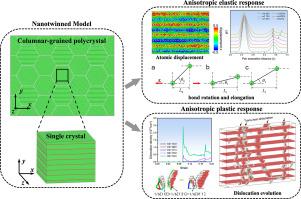纳米绕线金属各向异性弹性和塑性响应的原子学研究
IF 3.4
3区 材料科学
Q2 MATERIALS SCIENCE, MULTIDISCIPLINARY
引用次数: 0
摘要
在材料中引入纳米孪晶是实现强度和延展性协同提高的重要强化方法之一。人们通过实验和计算方法对纳米绕线材料的各向异性力学行为进行了广泛研究。位错滑移的主要变形机制可在三种模式中有效切换,并受孪晶间距以及孪晶边界(TBs)方向与加载方向之间夹角的控制。特别是,以往的研究大多集中于塑性流动阶段的变形机制,而对弹性阶段孪晶边界的各向异性特征关注较少,而这也是制造高性能材料的关键。因此,本研究旨在通过分子动力学(MD)模拟系统研究单晶或多晶体系中 TB 在弹性和塑性阶段的各向异性效应。研究发现,当加载方向平行于孪晶平面时,在单晶模型中引入 TBs 会显著影响原子键旋转和伸长主导弹性变形的特性,从而改变材料的泊松比,产生弹性软化行为和不均匀弹性变形。在塑性流动阶段,当加载方向从平行于 TBs 方向变为垂直于 TBs 方向时,变形机制从跨双位错滑移转变为硬模式 I 和穿线位错滑移(硬模式 II)并存。此外,跨双位错交汇处的位错段在提高材料强度方面发挥着重要作用。多晶模型的结果与单晶模型的结果一致。这些发现有望通过应变工程和缺陷调控,为高性能纳米结构材料的结构和功能应用开发带来益处。本文章由计算机程序翻译,如有差异,请以英文原文为准。

Atomistic investigation on the anisotropic elastic and plastic responses of nanotwinned metals
Introducing nanotwins into materials is one of the important strengthening methods to achieve the synergistic improvement of strength and ductility. The anisotropic mechanical behaviors of nanotwinned materials have been widely studied by experimental and computational methods. The dominant deformation mechanisms about dislocation slippages can be effectively switched among three modes, and controlled by twin spacing and the angle between twin boundaries (TBs) orientation and loading direction. Particularly, most of previous researches mainly focused on the deformation mechanisms during the plastic flow stage and researchers paid little attention on the anisotropic characteristics of TBs at the elastic stage which are also essential to manufacture the high-performance materials. Therefore, this study is aiming to systematically investigate the anisotropic effect of TBs both at the elastic and plastic stages within the single crystalline or polycrystalline systems by molecular dynamics (MD) simulations. It is revealed that, when the loading direction is parallel to twin planes, the introduction of TBs in single crystalline models will significantly affect the characteristics of atomic bond rotation and elongation dominated elastic deformation, which can alter the Poisson’s ratio of materials, generate elastic-softening behavior and inhomogeneous elastic deformation. At the plastic flow stage, the deformation mechanism transforms from trans-twin dislocation slippage into the coexistence of Hard Mode I and threading dislocation slippage (Hard Mode II) when the loading direction changes from parallel to perpendicular direction with respect to TBs. Moreover, the dislocation segments at the conjunction of trans-twin dislocation play a momentous role in enhancing material strength. The results for polycrystalline models are consistent with that of single crystalline ones. These findings are expected to be beneficial for the development of high-performance nanostructured materials for structural and functional applications by strain engineering and defect regulation.
求助全文
通过发布文献求助,成功后即可免费获取论文全文。
去求助
来源期刊

Mechanics of Materials
工程技术-材料科学:综合
CiteScore
7.60
自引率
5.10%
发文量
243
审稿时长
46 days
期刊介绍:
Mechanics of Materials is a forum for original scientific research on the flow, fracture, and general constitutive behavior of geophysical, geotechnical and technological materials, with balanced coverage of advanced technological and natural materials, with balanced coverage of theoretical, experimental, and field investigations. Of special concern are macroscopic predictions based on microscopic models, identification of microscopic structures from limited overall macroscopic data, experimental and field results that lead to fundamental understanding of the behavior of materials, and coordinated experimental and analytical investigations that culminate in theories with predictive quality.
 求助内容:
求助内容: 应助结果提醒方式:
应助结果提醒方式:


